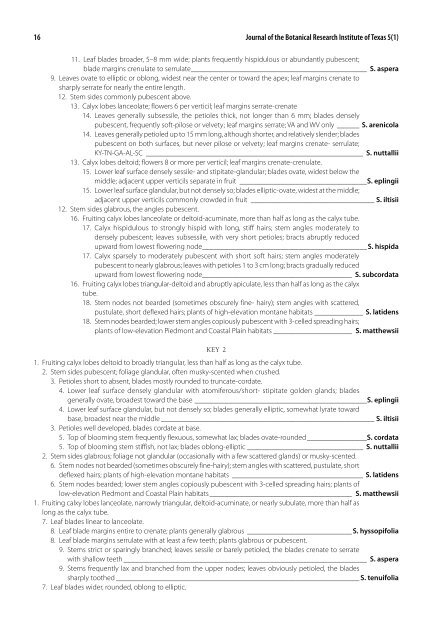(Stachys: Lamiaceae) from the - Botanical Research Institute of Texas
(Stachys: Lamiaceae) from the - Botanical Research Institute of Texas
(Stachys: Lamiaceae) from the - Botanical Research Institute of Texas
You also want an ePaper? Increase the reach of your titles
YUMPU automatically turns print PDFs into web optimized ePapers that Google loves.
16 Journal <strong>of</strong> <strong>the</strong> <strong>Botanical</strong> <strong>Research</strong> <strong>Institute</strong> <strong>of</strong> <strong>Texas</strong> 5(1)<br />
11. Leaf blades broader, 5–8 mm wide; plants frequently hispidulous or abundantly pubescent;<br />
blade margins crenulate to serrulate _______________________________________________ S. aspera<br />
9. Leaves ovate to elliptic or oblong, widest near <strong>the</strong> center or toward <strong>the</strong> apex; leaf margins crenate to<br />
sharply serrate for nearly <strong>the</strong> entire length.<br />
12. Stem sides commonly pubescent above.<br />
13. Calyx lobes lanceolate; flowers 6 per verticil; leaf margins serrate-crenate<br />
14. Leaves generally subsessile, <strong>the</strong> petioles thick, not longer than 6 mm; blades densely<br />
pubescent, frequently s<strong>of</strong>t-pilose or velvety; leaf margins serrate; VA and WV only ______ S. arenicola<br />
14. Leaves generally petioled up to 15 mm long, although shorter, and relatively slender; blades<br />
pubescent on both surfaces, but never pilose or velvety; leaf margins crenate- serrulate;<br />
KY-TN-GA-AL-SC __________________________________________________________ S. nuttallii<br />
13. Calyx lobes deltoid; flowers 8 or more per verticil; leaf margins crenate-crenulate.<br />
15. Lower leaf surface densely sessile- and stipitate-glandular; blades ovate, widest below <strong>the</strong><br />
middle; adjacent upper verticils separate in fruit __________________________________S. eplingii<br />
15. Lower leaf surface glandular, but not densely so; blades elliptic-ovate, widest at <strong>the</strong> middle;<br />
adjacent upper verticils commonly crowded in fruit _________________________________ S. iltisii<br />
12. Stem sides glabrous, <strong>the</strong> angles pubescent.<br />
16. Fruiting calyx lobes lanceolate or deltoid-acuminate, more than half as long as <strong>the</strong> calyx tube.<br />
17. Calyx hispidulous to strongly hispid with long, stiff hairs; stem angles moderately to<br />
densely pubescent; leaves subsessile, with very short petioles; bracts abruptly reduced<br />
upward <strong>from</strong> lowest flowering node ____________________________________________ S. hispida<br />
17. Calyx sparsely to moderately pubescent with short s<strong>of</strong>t hairs; stem angles moderately<br />
pubescent to nearly glabrous; leaves with petioles 1 to 3 cm long; bracts gradually reduced<br />
upward <strong>from</strong> lowest flowering node ________________________________________ S. subcordata<br />
16. Fruiting calyx lobes triangular-deltoid and abruptly apiculate, less than half as long as <strong>the</strong> calyx<br />
tube.<br />
18. Stem nodes not bearded (sometimes obscurely fine- hairy); stem angles with scattered,<br />
pustulate, short deflexed hairs; plants <strong>of</strong> high-elevation montane habitats _____________ S. latidens<br />
18. Stem nodes bearded; lower stem angles copiously pubescent with 3-celled spreading hairs;<br />
plants <strong>of</strong> low-elevation Piedmont and Coastal Plain habitats _____________________ S. mat<strong>the</strong>wsii<br />
key 2<br />
1. Fruiting calyx lobes deltoid to broadly triangular, less than half as long as <strong>the</strong> calyx tube.<br />
2. Stem sides pubescent; foliage glandular, <strong>of</strong>ten musky-scented when crushed.<br />
3. Petioles short to absent, blades mostly rounded to truncate-cordate.<br />
4. Lower leaf surface densely glandular with atomiferous/short- stipitate golden glands; blades<br />
generally ovate, broadest toward <strong>the</strong> base ______________________________________________S. eplingii<br />
4. Lower leaf surface glandular, but not densely so; blades generally elliptic, somewhat lyrate toward<br />
base, broadest near <strong>the</strong> middle _________________________________________________________ S. iltisii<br />
3. Petioles well developed, blades cordate at base.<br />
5. Top <strong>of</strong> blooming stem frequently flexuous, somewhat lax; blades ovate-rounded ________________S. cordata<br />
5. Top <strong>of</strong> blooming stem stiffish, not lax; blades oblong-elliptic _______________________________ S. nuttallii<br />
2. Stem sides glabrous; foliage not glandular (occasionally with a few scattered glands) or musky-scented.<br />
6. Stem nodes not bearded (sometimes obscurely fine-hairy); stem angles with scattered, pustulate, short<br />
deflexed hairs; plants <strong>of</strong> high-elevation montane habitats ___________________________________ S. latidens<br />
6. Stem nodes bearded; lower stem angles copiously pubescent with 3-celled spreading hairs; plants <strong>of</strong><br />
low-elevation Piedmont and Coastal Plain habitats ______________________________________ S. mat<strong>the</strong>wsii<br />
1. Fruiting calxy lobes lanceolate, narrowly triangular, deltoid-acuminate, or nearly subulate, more than half as<br />
long as <strong>the</strong> calyx tube.<br />
7. Leaf blades linear to lanceolate.<br />
8. Leaf blade margins entire to crenate; plants generally glabrous ____________________________ S. hyssopifolia<br />
8. Leaf blade margins serrulate with at least a few teeth; plants glabrous or pubescent.<br />
9. Stems strict or sparingly branched; leaves sessile or barely petioled, <strong>the</strong> blades crenate to serrate<br />
with shallow teeth _________________________________________________________________ S. aspera<br />
9. Stems frequently lax and branched <strong>from</strong> <strong>the</strong> upper nodes; leaves obviously petioled, <strong>the</strong> blades<br />
sharply too<strong>the</strong>d _________________________________________________________________ S. tenuifolia<br />
7. Leaf blades wider, rounded, oblong to elliptic.
















